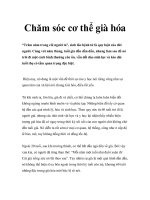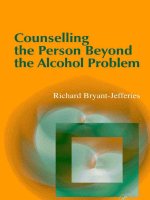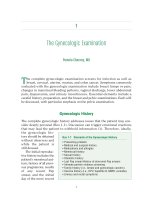Counselling the Person Beyond the Alcohol Problem potx
Bạn đang xem bản rút gọn của tài liệu. Xem và tải ngay bản đầy đủ của tài liệu tại đây (673.35 KB, 236 trang )
Counselling the Person Beyond
the Alcohol Problem
of related interest:
Rehabilitation Counselling in Physical and Mental Health
Edited by Kim Etherington
ISBN 1 85302 968 8
Counsellors in Health Settings
Edited by Kim Etherington
Foreword by Tim Bond
ISBN 1 85302 938 6
Parental Substance Misuse and Child Welfare
Brynna Kroll and Andy Taylor
ISBN 1 85302 791 X
Good Practice in Counselling People Who Have Been Abused
Edited by Zetta Bear
ISBN 1 85302 424 4
Narrative Approaches to Working with Adult Male Survivors
of Child Sexual Abuse
The Clients’, the Counsellor’s and the Researcher’s Story
Kim Etherington
ISBN 1 85302 818 5
Addictions and Problem Drug Use
Issues in Behaviour, Policy and Practice
Edited by Mick Bloor and Fiona Wood
ISBN 1 85302 438 4
Understanding Drugs
A Handbook for Parents, Teachers and Other Professionals
David Emmett and Graeme Nice
ISBN 1 85302 400 7
Surviving Post-Natal Depression
At Home, No One Hears You Scream
Cara Aiken
ISBN 1 85302 861 4
Counselling the Person
Beyond the Alcohol Problem
Richard Bryant-Jefferies
Jessica Kingsley Publishers
London and Philadelphia
All rights reserved. No part of this publication may be reproduced in any
material form (including photocopying or storing it in any medium by electronic
means and whether or not transiently or incidentally to some other use of this
publication) without the written permission of the copyright owner except in
accordance with the provisions of the Copyright, Designs and Patents Act 1988
or under the terms of a licence issued by the Copyright Licensing Agency Ltd, 90
Tottenham Court Road, London, England W1P 9HE. Applications for the
copyright owner’s written permission to reproduce any part of this publication
should be addressed to the publisher.
Warning: The doing of an unauthorised act in relation to a copyright work may
result in both a civil claim for damages and criminal prosecution.
The right of Richard Bryant-Jeffries to be identified as author of this work has
been asserted by him in accordance with the Copyright, Designs and Patents Act
1988.
First published in the United Kingdom in 2001
by Jessica Kingsley Publishers Ltd
116 Pentonville Road
London N1 9JB, England
and
325 Chestnut Street
Philadelphia, PA 19106, USA
www.jkp.com
Second Impression 2002
Copyright © 2001 Richard Bryant-Jeffries
Library of Congress Cataloging in Publication Data
Bryant-Jeffries, Richard.
Counselling the person beyond the alcohol problem / Richard Bryant-Jeffries.
p. cm.
Includes bibliographical references and index.
ISBN 1-84310-002-9 (pbk. : alk. Paper)
1. Alcoholics Counseling of. 2. Client-centered psychotherapy. 3.
Alcoholism Psychological aspects. 4. Behaviour modification. I. Title.
HV5275 .B78 2001
362.292’86 dc21
2001029758
British Library Cataloguing in Publication Data
A CIP catalogue record for this book is available from the British Library
ISBN 1 84310 002 9
Printed and Bound in Great Britain
by Athenaeum Press, Gateshead, Tyne and Wear
Contents
DEDICATION 7
ACKNOWLEDGEMENTS 8
PREFACE 9
Introduction 11
1 Entering the World of Alcohol Use 25
2 Alcohol in the Family 45
3 Application of a Person-Centred Approach 71
4 The Cycle of Change 103
5 From Pre-Contemplation to Taking Action 133
6 Maintaining Change and Responding
to Relapse
169
7 Bringing It All Together 193
8 Conclusion 217
REFERENCES 225
FURTHER READING 228
SUBJECT INDEX 231
AUTHOR INDEX 235
To Stuart,
who helped me when I was younger but whom I
could not help because I did not understand
what an alcohol problem was
Acknowledgements
First and foremost I wish to acknowledge the clients with whom I have
worked, who have brought me so much learning and who, in the final
analysis, have been and are the true inspiration for writing this book.
Hearing their experiences and their struggles, sharing in the process of
formulating strategies for sustainable change, or simply being there
with them as the one person who is listening, is a privileged position in
which to be. My most important training ground has been, without
doubt, the experience of working with the clients themselves. Without
them, this book could not, and would not, have been written.
Whenever I have mentioned to people that I am writing this book, I
have consistently received positive responses. Clients, professionals and
friends have all commented that there is a need for a book to help people
access ideas and informed perspectives on problematic drinking that
draws on person-centred ideas and the experience of working with
people who are affected by it. This has contributed to my perseverance
in completing this book.
I would like to thank Tony Merry, Dave Mearns and Sue Wilders for
their challenging and supportive comments on earlier drafts. I would
also like to give thanks to Pippa Glassock, David Voyle, Patrick Coyne
and the many others who have provided me with valuable feedback and
encouragement.
Finally, I want to thank Lynn Frances, my partner, who has
contributed not only her editorial skills to the production of this book,
but also consistent emotional support, especially during my periods of
self-doubt and of wondering if it would ever come together. Her ability
to be touched by the content of the book, and her belief in it has been a
source of encouragement throughout. Thank you, Lynn.
Note
The dialogues with clients in the book are fictional. Any actual words of
clients are reproduced here with the permission of those involved.
Preface
I do not know what prompted me to apply for the post of
Primary Health Care Alcohol Liaison Worker and Counsellor
with the Acorn Community Drug and Alcohol Service in
Surrey, other than that it somehow felt right. I had not previ
-
ously had experience of working with people with alcohol
problems. It was late 1994 and I had recently left my job as a
Fundholding Manager at a GP surgery in Guildford, having
earlier completed my diploma training in person-centred
counselling and psychotherapy. I had chosen the person-
centred approach because it offered me a way of working with
people that made so much sense. My training reinforced my
belief in the importance of having genuine respect for other
people. I experienced the reality of the ‘facilitative climate’
through which growth can occur. I was fired up with the ideas
of Carl Rogers, keen to apply them in my new career of
counsellor.
It was while I filled in my application form that I knew it
was the job for me. I had not previously thought of working in
this area, yet looking back now I see that I owe a great deal to a
past experience that I had thought was forgotten. Some years
before, a manager of mine had had an alcohol problem and
while aware of it I had no idea what to do, or how to help. The
job application reconnected me with that experience. With
hindsight, I could have done something. At the time, though, I
was not in the right place within myself to offer anything; I
certainly had no concept of how damaging and life-threaten
-
ing a serious alcohol problem can be. He died and somehow
the seriousness of his drinking did not impress itself on me
until his locker was discovered to be full of empty sherry
9
10 COUNSELLING THE PERSON BEYOND THE ALCOHOL PROBLEM
bottles. I think it is easy not to recognize a drinking problem
sometimes, particularly when you enjoy a few drinks yourself.
My role at Acorn since 1995 has been to provide an alcohol
counselling service to patients at a number of GP surgeries in
south-west Surrey. It has been both a challenging and enrich
-
ing experience. The challenges have been in the form of the
settings (which are often not conducive to counselling), and
the diagnostic emphasis that so differs from a purely
person-centred way of working. The enrichment has come
through working within a team of committed individuals and
from the clients themselves with their diverse, and often trau
-
matic, life-experiences, and struggles to change.
There has to be a belief within the counsellor that he or she
can work with clients who have alcohol problems. There is a
need for them to feel adequate to the task ahead. I have noticed
how few courses training people in counselling and psycho-
therapy include modules on alcohol awareness and response.
Dryden and Feltham (1994) have highlighted the need for
trainers to alert students to issues concerned with working
with problem drinkers. I am also struck, again and again, by the
low expectations among professionals and volunteers of
working with people who have alcohol problems. Yet with
alcohol-related problems becoming a consistent and growing
feature of our society, more and more health and social care
professionals, and indeed everyone in the community as well,
will find themselves having to respond to people who for one
reason or another are demonstrating problems with alcohol.
Introduction
Alcohol use is a common enough feature of life at the begin
-
ning of the twenty-first century, as it has been for thousands of
years. Most people enjoy the effects of alcohol, the ‘oiling of
the social wheels’, the complement of a glass of wine with a
meal, a few pints on a summer’s day with friends in the beer
garden or accompanying a few games of darts, that gin and
tonic to relax at the end of a stressful day, or a relaxing of inhi
-
bitions so you can really enjoy yourself at a party. We like the
‘loosening up’ effect alcohol can have on us, the taste and the
sensation of a pleasant glow in our throats and stomachs.
However, for many this is not where the experience stops, or
indeed begins. For them the urge to drink alcohol is over-
whelming and the idea of cutting back or stopping is unthink-
able or felt to be impossible.
Labelling
I have chosen the title for this book carefully. What has struck
me most forcibly is the need to look beyond the labels attached
to people and thus engage with the person himself. For
instance, the word ‘alcoholic’ can bring up a range of images
and thoughts:
º
down and out
º
sherry bottles in coat pockets
º
having to drink every morning to stop shaking
º
being unable to contribute to society
º
being a waste of everyone’s time
º
being dangerous.
11
12 COUNSELLING THE PERSON BEYOND THE ALCOHOL PROBLEM
The label can create a barrier to seeing the person, making it
difficult to acknowledge their potential, or achievements, their
whole personhood. Added to this is the question of when such
a label would be appropriate anyway:
º
the professional drinking half a bottle of whisky or
more a day to cope with pressure at work
º
the company director daily consuming a bottle of wine
plus gin and tonics while entertaining clients
º
the single parent of either sex using alcohol to unwind
and relax at the end of every day
º
the sportsperson regularly celebrating successes with
heavy alcohol use, or using alcohol to relax every time
he steps out in front of 50,000 people.
Are these people ‘alcoholics’? They may be unable to choose
not to have their alcohol, yet they are far from the usual ‘alco-
holic’ image many people have.
A label such as ‘alcoholic’ denies many other aspects of a
person’s life. It can certainly serve to obscure the recognition
of an individual’s uniqueness. I have sat in alcohol support
groups struck by the rich diversity of skills, talents and experi-
ences among those attending: professionals from all walks of
life, people juggling work and a hectic home-life. Yet it is all
too easy for someone to say they are just a group of alcoholics
and lose sight of a greater reality.
The ‘alcoholic’ label can reduce any expectation of change.
Maybe the person will not be able to change a drinking habit,
maybe they will. Only time will tell. Being labelled ‘alcoholic’
can discourage some from trying, encouraging in them a sense
of disempowerment, possibly exacerbating an already poor
self-image. It can certainly be experienced as very judge
-
mental. Having said that, many people see the label positively
as a way of identifying themselves with a group within society;
13 INTRODUCTION
this can strengthen their sense of identity and of not being
alone with their problem. For many people the very fact of
having a name for their problem can help them to accept it.
Not a simple disease
Over the years, an approach to treatment that is effective for all
‘alcoholics’ has been sought, but not found (Donovan and
Mattson 1994). This probably stems from the general clinical
view that specific diseases will respond to specific treatments
and that, if you can find the ‘right’ one, you will cure the
disease. However, the Centre for Research on Drugs and
Health Behaviour (1994, p.1) suggests that ‘no one approach
to the treatment of alcoholism has been proved, by research, to
be superior to any other for all problem drinkers’.
This is because we are not talking about a simple disease,
rather a behaviour that has its roots in all kinds of emotional
difficulties and distorted self-concepts stemming from condi-
tional experiences, for instance, the negative and judgemental
reactions of significant others, or significant losses and other
traumatic experiences. Heather and Robertson (1989) suggest
that problem drinking should be regarded not as disease but as
a learned behavioural disorder. Problematic drinking can be a
person’s way of coping with a loss, or it may simply be a habit,
the result of a heavy drinking lifestyle that is normal within a
given culture. In Fossey (1994), Plant emphasizes that there
are a number of factors that contribute to a developing
drinking habit which include a whole range of social and envi
-
ronmental factors as well as the individual personality of the
drinker, their genetic make-up and their unique life circum
-
stances. Excessive levels of alcohol use have been identified as
a ‘maladaptive coping strategy’ for dealing with stress and
anxiety (Powell and Enright 1990).
14 COUNSELLING THE PERSON BEYOND THE ALCOHOL PROBLEM
The counsellor has to be empathic to the individual client’s
perception of, and the meaning they attach to, their use of
alcohol. Each person has his or her own unique story to tell,
and the role of the counsellor is to listen and enable the client
to feel heard. We can sometimes overlook the power of giving
someone time to be listened to; it is here that therapeutic
contact begins, or is lost. Many clients using alcohol to cope
with traumatic life-experiences have never before told their
story, never been given the opportunity, or felt able to take the
risk, fearful of ridicule and rejection, overwhelming shame, or
simply of not being believed. I frequently find myself in awe of
the experiences people have had, or are having, touched by the
hurt and anguish present as they share their world. I find it
very humbling, particularly when I have the sense of being the
first person to hear a painful and difficult life-story.
Project MATCH
The increasing recognition that there is no single treatment
that is the most effective, led to the development of the
hypothesis that clients would do better if matched with partic-
ular treatments that addressed, and were better suited to, indi-
vidual needs and characteristics. The 1994 Report to the
Alcohol Education and Resource Council (UK) by the Centre
for Research on Drugs and Health Behaviour (p.3) stated that
‘we are still a long way from knowing whether treatment
outcome can be improved by “matching” and which are the
important “matching” variables’.
A call for further research led the US National Institute on
Alcohol Abuse and Alcoholism to mount a large-scale
1
matching study. Project MATCH
has been associated with an
enormous amount of research, looking specifically at the issue
of matching alcohol-dependent clients with three particular
treatments: Twelve Step Facilitation Therapy (Alcoholics
15 INTRODUCTION
Anonymous-based), Cognitive-Behavioural Coping Skills
Therapy and Motivational Enhancement Therapy. One con
-
clusion has been that they could all be helpful so long as the
skilled helper was well trained to work within a clearly
defined, structured framework.
On the surface, matching clients might be seen by some to
be ‘client-centred’; however, client-centred practice is not
about how an ‘expert’ chooses a treatment for a client, but how
the therapist and client work together and form a therapeutic
alliance. This relationship is a key factor. How this may influ
-
ence continuance of contact and outcome in relation to
helping problematic drinkers is itself an area for further study,
a fact also highlighted in the 1994 report. My focus is towards
not so much what we do with our clients as how we are when we
are with them.
Project MATCH is without doubt the largest research
project on helping people with alcohol problems. With data
still being made public, and papers continuing to be written, it
is providing a vast amount of material to inform practice. It is a
pity it only addresses three types of treatment.
Motivational interviewing
Miller, who has developed the ‘motivational interviewing’
approach to working with people with alcohol problems,
suggests that confrontational approaches are counter-thera
-
peutic and that the attributes of Rogers are really a basis from
which motivational interventions should be developed (Miller
1985). In client-centered therapy confrontation is not used as a
technique. However, the client will at times feel internally con
-
fronted by his own incongruence and anxieties as a result of
experiencing empathy, congruence and unconditional positive
regard being communicated by the counsellors. Motivational
16 COUNSELLING THE PERSON BEYOND THE ALCOHOL PROBLEM
interviewing is an approach used widely in addiction services
and is
designed to help clients build commitment and reach a
decision to change. It draws on strategies from
client-centred counselling, cognitive therapy, systems
theory, and the social psychology of persuasion. The
appearance of a motivational interviewing session is quite
client-centred; yet the counsellor maintains a strong sense
of purpose and direction, and actively chooses the right
moment to intervene in incisive ways. In this sense, it
combines elements of directive and non-directive
approaches. (Miller and Rollnick 1991, p.x)
Many would question whether this is truly client-centred, and
I was among them until I met William Miller and was struck by
his way of being and fundamental respect for clients. Now I
would regard motivational interviewing as an application of a
person-centred approach rather than a strictly client-centred
therapy in the non-directive sense of Rogers.
Alcoholics Anonymous
A book written about helping people with alcohol problems
would not be complete without mention of Alcoholics Anony-
mous (AA); it is such a powerful influence over people’s
thinking about alcohol problems. The Twelve Step
programme, the participation in meetings and the support
from ‘sponsors’ enables many people to take greater control
over their lives. Counsellors and psychotherapists need to be
2
aware of the Twelve Step process
as some of their clients will
be using it.
It is enormously helpful that AA meetings are available,
offering people the possibility of support on a daily basis.
Some people choose to attend meetings simply as a way of
breaking up a daily drinking habit, and/or for getting
17 INTRODUCTION
much-needed social contact. They are not so concerned with
‘working the programme’, and, while this can be helpful, the
danger is that they remain at a stage that might be termed ‘the
dry drunk’, not drinking, but not really changing. Others do
change, working through the programme and at their
recovery, and at playing an active part in the process of
ongoing support and encouragement of others. Recovery is
not just about not drinking, but is also very much about over
-
coming the emotional and mental attachments to an
alcohol-centred lifestyle.
It seems that AA largely caters for those who are or have
been at the extreme end of the drinking continuum. One criti
-
cism could be that it offers little in the way of preventive work,
or of help to avoid developing a more serious alcohol problem
at the point where alcohol use is only just beginning to
generate problematic effects. Ward and Goodman (1995)
comment that the AA message of abstinence is an extreme
response to extreme situations. AA has three areas of emphasis
that I have heard people indicate as being difficult for them to
accept: adoption of the ‘alcoholic’ label; the use of language
that implies ‘alcoholics’ are always ‘in recovery’; the reli-
gious/spiritual angle within the Twelve Steps and the
emphasis on a ‘higher power’. Nevertheless, the fact is that AA
helps many, and offers more in terms of availability of support
on a 24-hour basis around the world than any other agency
can hope to offer, but it is not for everyone.
Person-centred perspective
The key to the person-centred perspective on working with
people with alcohol problems is that the focus is on the client,
on the person him or herself, with the client having autonomy
in choosing where to place the emphasis. It suggests that we
are all subject to what Rogers termed ‘the actualizing
18 COUNSELLING THE PERSON BEYOND THE ALCOHOL PROBLEM
tendency’. Bozarth (1998, p.6) describes this as ‘the founda
-
tion block of person-centred therapy’ and goes on to quote
Rogers:
Practice, theory and research make it clear that the
person-centred approach is built on a basic trust in the
person … [It] depends on the actualizing tendency present
in every living organism’s tendency to grow, to develop, to
realize its full potential. This way of being trusts the
constructive directional flow of the human being toward a
more complex and complete development. It is this
directional flow that we aim to release. (Rogers 1986,
p.198)
The person-centred perspective emphasizes the client’s poten
-
tial to become a more integrated, satisfied and fulfilled person.
It acknowledges the client’s unique heritage of experience and
identity. The therapeutic relationship in which empathy, genu-
ineness and unconditional positive regard are present serves to
empower the client, as a person in his or her own right, to
make the choices that will enable them to have a more fulfilling
lifestyle. This generally involves resolving fragmentation
within the self and taking back control from external factors
such as alcohol through a process of developing greater inte-
gration and self-reliance.
Many problem drinkers, engaging in a person-centred rela
-
tionship, can begin to gain a realistic sense of themselves and
unravel distortions within their self-concept stemming from
past experiences. Their alcohol use may be an expression of a
sense of self developed through negative or inconsistent con
-
ditioning, a way of dealing with feelings and anxieties that
have become established through experiences in life. It
becomes an expression of the person seeking to do the best he
can as he seeks to preserve an identity that is familiar to him
and that satisfies the conflicting demands of elements within
19 INTRODUCTION
his self-concept. Many of the people I see with alcohol
problems are experiencing low self-esteem and a poor
self-image. The therapeutic process helps the person to feel
validated and accepted. It can have an empowering effect with
the person growing towards a greater realization of his poten
-
tial as a person.
I would suggest that where a person can be engaged with in
such a way that he can fully and genuinely explore his choices
in life in a warm and accepting relationship, including his
choice to use alcohol and its associated meanings and elements
within his self-concept, then he is likely to choose to cultivate
new habits and patterns of living, and develop a fresh
self-concept that leads to less alcohol-reliance and greater
self-reliance.
People need a range of options with regard to the forms of
therapeutic support they receive and my experience is that the
person-centred approach does offer a real opportunity for
growth and alternative choices of lifestyle. It has application
regardless of whether the client has a serious alcohol problem,
is only beginning to experience problematic effects from
alcohol use, or simply does not appreciate that his alcohol use
is a problem.
Working with clients who are faced with the need to
change a habit or a lifestyle can lead to the unexpected. Clients
find themselves challenging attitudes and assumptions that
previously were very much accepted and integrated into their
way of being. Perceptions of past experiences are revisited and
may be adjusted as feelings and anxieties are re-experienced in
the context of the therapeutic relationship. The individual’s
sense of self can undergo tremendous shifts, and life can take
on new meaning and fresh direction. For me, this is the attrac
-
tion of counselling and, in particular, of working with this
client group. The counsellor shares part of their journey into
what can often be the unknown and the unexplored. It is a time
20 COUNSELLING THE PERSON BEYOND THE ALCOHOL PROBLEM
of fear and hurt, of joy and creativity. It is not about finding
solutions for people, but rather helping to create the climate within
which solutions may emerge.
There is an ongoing debate within ‘the world of alcohol
counselling as to whether a professional counsellor who is not a
recovering alcoholic can be truly empathic and helpful’
(Feltham 1995, p.20). It can be valuable for someone to hear
another’s story, confirming his or her experiences. I have heard
it said at alcohol support groups: ‘I am here because the people
here have had similar experiences’; ‘I do not need to keep
explaining myself. I can feel accepted for who I am’; ‘Hearing
someone else having similar struggles makes me feel less alone
with my problems’. Yet in spite of this commonality, each
person has his own way of interpreting experiences and
shaping his sense of self and behaviour in response. Not
everyone attaches the same meaning to his or her alcohol use.
In entering the client’s world of experience, I endeavour to
guard against making assumptions. A counsellor who has had
an alcohol problem is challenged to hear the client’s experi-
ences and the meaning he or she attributes to them, and has to
guard against believing that his or her own experience is also
the client’s. I have to be careful that my knowledge of the
many psychological features that are common to this client
group do not obstruct or distort my hearing of what the client
is telling me. I myself have not had an alcohol problem, and
have been virtually teetotal for the last decade or so. This was
mainly due to finding that I had developed some kind of sensi
-
tivity to alcohol that left me feeling awful after just one drink.
Yet my not drinking does not seem to be a problem in working
with this client group. I may not have the actual experience of a
drinking problem, but I am able to empathize with the
thoughts and feelings experienced and communicated by my
clients.
21 INTRODUCTION
Aims of the book
While many of the ideas in this book are applicable for
working with people who have other addictive problems, its
primary aim is to help counsellors, therapists and all health and
social care professionals to feel better equipped and more opti
-
mistic in working with people who have formed a problematic
relationship with alcohol. Attitudes to working in this area of
counselling are addressed. Particular issues concerned with
problematic drinking among both young and old are consid
-
ered, together with its effect on the family. The application of
the person-centred approach is explored and what this particu
-
lar approach has to offer the heavy or problematic drinker. The
‘stages of change’ model devised by Prochaska and
DiClemente (1982), which is used widely in addiction
services, is described. It offers a framework in which to work
that I have found helpful. The attempt is made to demonstrate
how the person-centred approach to counselling can be
applied within this framework. Scenarios are given, together
with sample dialogue to illustrate what can be offered. The
attempt is made to help the reader appreciate a little more the
world of the person with an alcohol problem, emphasizing
that therapeutic bridges can be built and change for the better
can occur, given the creation of a facilitative climate between
therapist and client.
An important part of this book is the contribution from
clients who express what they have found helpful and unhelp
-
ful from counsellors, friends and relatives as they have sought
to come to terms with and resolve an alcohol problem. They
also share what they feel society’s view is of their plight. Some
of these client perspectives have been written by people who
use AA, and some by those who do not. Some accept the ‘alco
-
holic’ description, others do not. I value their courage in
22 COUNSELLING THE PERSON BEYOND THE ALCOHOL PROBLEM
speaking out from their experience. It has been important for
me that they should have their say.
The scenarios are fictitious yet drawn from the experience
of working with this client group and the issues that arise. The
names are fictitious and offered simply to provide a less imper
-
sonal sense of the client. My intention is to provide an oppor
-
tunity to enter the client’s world and be touched by what is
said.
I am very aware of how little has been written on this topic
from a person-centred perspective. Since developing my own
speciality within this area, I often have counsellors contacting
me, particularly from the person-centred way of working,
asking what books are available specific to their approach. This
is one of my motivations for writing this book. I remain con
-
vinced that the person-centred approach contains factors that
are fundamental to enabling individuals to grow towards
achieving more fulfilling lifestyles. I can testify, through my
own practice, to the value of this approach, in helping people
overcome problems associated with alcohol use. This book
introduces the reader to the application of the person-centred
approach within the work of counselling people with alcohol
problems, and draws on other ideas that are widely used
within the field of addiction work.
I am aware that some of what I say may not sit comfortably
with everyone who describes themselves as ‘person-centred’ in
their therapeutic orientation. Some will argue that they would
not expect to raise the topics of alcohol use, relapse prevention
or planning change, but would allow the client to introduce
these themselves if they have relevance for the client’s inner
and outer experience. I also use words such as ‘strategy’, I talk
of ‘stages’ of change that could be viewed as categorization, I
offer ideas to clients that I believe might be helpful, and I have
an agenda: to help people who are experiencing the problem
-
23 INTRODUCTION
atic effect of alcohol use to reduce the damage they may be
doing to themselves and/or others.
What I have realized through my work, and this is my
personal view, is that while the therapeutic attitudes and values
of the person-centred approach have much to offer this client
group, other ideas can also be helpful. I hope that whatever
occurs in my relationship with clients will prove to be enabling
for them in achieving whatever they seek not only in the
context of their alcohol use, but also in their own process of
personal development.
One book cannot cover every aspect of the effects of
alcohol and the ways of responding. The topic of problematic
alcohol use is vast. This is not a medical book, or a treatment
manual. However, it will equip professionals and volunteers
who are called on to work with someone with an alcohol
problem with a range of ideas and a framework within which
both to build a therapeutic relationship and to offer the client
the opportunity of developing and sustaining a less alcohol-
centred lifestyle.
I hope this book will challenge you. I hope it will leave you
more optimistic than before. Most of all, I hope that it will help
all health and social care professionals to look beyond the
alcohol problem to the person who, more than anything else,
needs another human being to be a companion, someone who
will listen to his unique story and help him face up to difficul
-
ties that previously only alcohol eased, and to accept himself
in a fresh and more realistic manner. As Mearns and Thorne
(1988, p.6) have emphasized:
… the client can be trusted to find his own way forward if
only the counsellor can be the kind of companion who is
capable of encouraging a relationship where the client can
begin, however tentatively, to feel safe and to experience
the first intimations of self-acceptance.
24 COUNSELLING THE PERSON BEYOND THE ALCOHOL PROBLEM
Then the client may begin to uncover their hidden potential
for being human in a fuller and more satisfying way on the
road to greater self-reliance, and perhaps in so doing gain a
fresh perspective on their alcohol use and begin to make dif
-
ferent choices.
Endnotes
1 For more information contact: National Institute on Alco
-
hol Abuse and Alcoholism, (NIAAA), 600 Executive Boule
-
vard, Willco Building, Bethesda, MD, 20892–7003, USA.
2 Alcoholics Anonymous World Service Inc. (1976) Twelve
Steps and Twelve Traditions. New York: Alcoholics Anony
-
mous World Service Inc.









